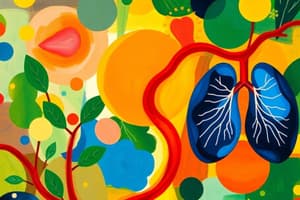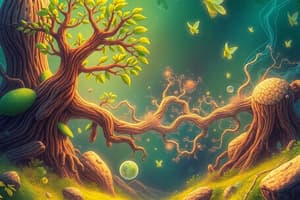Podcast
Questions and Answers
What processes are responsible for life on Earth?
What processes are responsible for life on Earth?
Photosynthesis and cellular respiration
What are autotrophs?
What are autotrophs?
- Organisms that cannot produce their own food
- Organisms that can produce their own food (correct)
- Organisms that rely on consuming other organisms
- None of the above
Heterotrophic organisms perform photosynthesis.
Heterotrophic organisms perform photosynthesis.
False (B)
What does the mitochondria produce from food?
What does the mitochondria produce from food?
Plants create their own food through the process of ______.
Plants create their own food through the process of ______.
Which of the following are types of plastids?
Which of the following are types of plastids?
What is the function of the cristae in mitochondria?
What is the function of the cristae in mitochondria?
What organelle contains chlorophyll?
What organelle contains chlorophyll?
Match the following types of plastids with their functions:
Match the following types of plastids with their functions:
Study Notes
Photosynthesis and Cellular Respiration
- Energy is required to carry out the functions required for life.
- Organisms obtain energy by consuming other organisms or from the environment.
- Photosynthesis and cellular respiration are two significant processes that interrelate to sustain life on Earth.
Autotrophs
- Plants, bacteria, and algae are autotrophs.
- They can make their own food by converting light energy into chemical energy.
- This process is called photosynthesis.
Photoautotrophs
- Photoautotrophs use sunlight and carbon dioxide to synthesize carbohydrates.
- Bacteria and algae are examples of photoautotrophs.
Heterotrophs
- Humans and animals are heterotrophs.
- They obtain energy by consuming other organisms.
Organelles
- Organelles are specialized structures within cells.
- They function like the organs of our bodies.
Mitochondria
- Mitochondria are the powerhouses of the cell.
- They break down carbon-containing molecules and release energy in the form of ATP.
- Mitochondria have a double membrane structure.
- They are spherical organelles.
- Mitochondria can synthesize proteins and divide independently of the cell's normal division cycle.
Cristae
- Cristae are folds in the inner mitochondrial membrane.
- They increase the surface area for energy production.
Matrix
- The mitochondrial matrix contains enzymes that convert pyruvate and fatty acids into acetyl CoA and oxidize it into CO2.
Chloroplasts
- Chloroplasts are the sites of photosynthesis in plant cells.
- They contain chlorophyll, a green pigment that captures sunlight.
- Chloroplasts have a double membrane structure.
- They are responsible for manufacturing and storing food in plant cells.
Plastids
- Plastids are double-membraned organelles found in plant cells.
- There are three types of plastids: chromoplasts, chloroplasts, and leucoplasts.
Chromoplasts
- Chromoplasts are responsible for the color of flowers and fruits.
Leucoplasts
- Leucoplasts store starch, lipids, and proteins.
Studying That Suits You
Use AI to generate personalized quizzes and flashcards to suit your learning preferences.
Related Documents
Description
Explore the vital processes of photosynthesis and cellular respiration through this quiz. Learn about autotrophs, photoautotrophs, and heterotrophs, as well as the role of organelles like mitochondria. Test your understanding of how energy is converted and utilized in living organisms.




